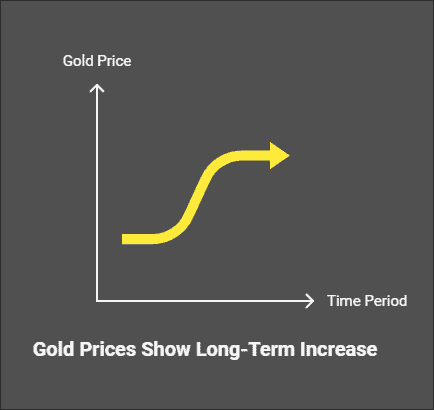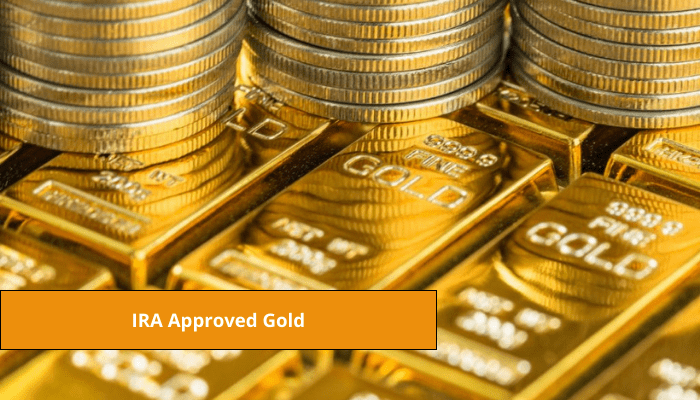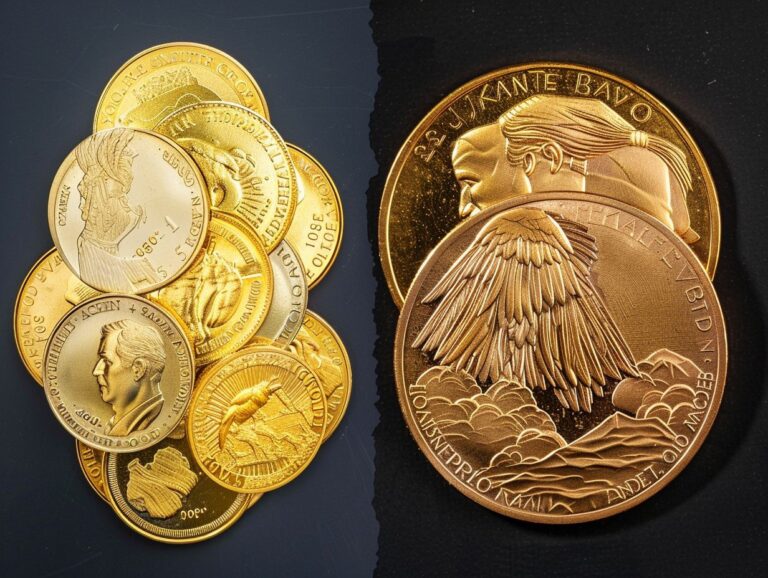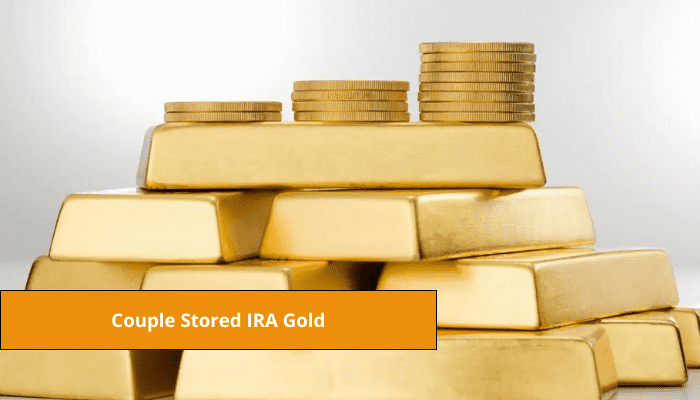
Since its initial smelting by the ancient Kemet people almost 5,000 years ago, gold has been a constant and dependable symbol of wealth and prestige across the entire world.
In present times, this valuable precious metal has been essential not only in creating stunning jewelry and delicate electronic components but also as a central element of investment portfolios.
Gold is an accessible investment sector that anyone can exploit with only basic knowledge. However, to truly understand the asset and become adept in reaping gold investment returns, we need to familiarize ourselves with the value of gold over time. This will provide a greater understanding of gold’s potential performance going forward.
Key Points
- Historical reliability of gold: For over 5,000 years, gold has been a symbol of wealth and a stable element in investment portfolios.
- Gold as an inflation hedge: Gold historically resists inflation and economic instability, retaining value over time.
- Portfolio diversification: Including gold in your portfolio can provide stability and reduce risk during market downturns.
- Gold’s resilience: Despite market fluctuations, gold has consistently maintained or increased its value, especially in times of economic uncertainty.
- Physical gold vs. gold stocks: Investing in physical gold involves storage and insurance costs, while gold stocks are subject to market volatility.
Historical Performance
Assessing the basic performance of gold over time will help you figure out certain financial objectives – your potential gold average return expectations – and better appreciate the appeal of gold in diversified investment strategies.
To coin a phrase often used by traders, when we ‘zoom out’ and see the bigger historical picture of gold, we can more confidently predict our gold ROI going forward.
Through this article, we intend to do just that. We shall ‘zoom out’ and take a brief view of gold through recent history and consider why gold is such a solid investment or store of value.
Is Gold a Strong Long-Term Investment?
There is no concrete answer when it comes to potential gold investment returns. Forecasting the future performance of any long-term investment, including gold, is always uncertain by nature.
However, when we examine the value of gold over time, it’s quite obvious that gold has remained a solid, dependable, and durable investment option, as it often maintains or increases its value. But the question remains, is gold a suitable investment?
It depends on what you expect out of your investments. The main limitation of gold is that, unlike some assets, gold does not necessarily yield dividends that can and will contribute to wealth accumulation through the notion of compounding. While gold is, of course, a good store of value, it tends to lack the ability to generate ongoing cash flow.
Now, this is inherently different from a collection of dividend-paying stocks, for example, which can provide regular income unless the gold is sold. Consequently, most investment specialists advise against relying on precious metals like gold for short-term investment strategies.
Anyone who advises the contrary could not be considered a true ‘specialist’ who understands gold investment, as gold does not usually deliver a fast rate of return. Gold investment returns are more of a long-term expectation that do not always generate quick profits.
Gold in Diversified Portfolios
However, including gold in a diverse portfolio can provide balanced exposure. Investing in gold is frequently seen as a wise move in times of market turbulence, offering a hedge against inflation, with demand and price that typically rise when stock markets fall.
This counter-movement has always made gold an appealing option for investors looking to safeguard their assets during ever increasingly frequent economic downturns.
Gold somehow straddles the line between being a currency and a commodity without wandering too far in either direction. But it is not without its risks, which include (for the most part) price volatility. However, the return on gold in the last 10 years contradicts that statement somewhat. More on that later.
Gold’s Average Investment Returns
While gold doesn’t necessarily generate a revenue stream, it has historically served as a reliable store of value that often appreciates over time.
In fact, if we analyze the value of gold over time, the global average annual return on gold from 1971 – the very year that gold’s price was controversially decoupled from the U.S. dollar – all the way through to the present date (2024, at time of writing), the figure stands at approximately 8%.

That is quite a remarkable number, you may agree. However, yearly returns are another matter entirely and can vary greatly. For example, in 2022, gold’s annual return was a modest 0.42%.
Methods of gold investment usually encompass buying physical gold or investing in gold-focused companies through the vehicle of stocks or mutual funds, and each method comes with its own set of costs. Physical gold, for example, might include storage and insurance fees. By the same token, investing in gold stocks or funds through a brokerage account or investing in a gold IRA often (but not always) incurs fund management fees.
Tracking Gold’s Historical Performance
Over several decades, the price trajectory of gold has experienced both upward trends and periods of fluctuation. Prior to 1971, the U.S. always maintained the world-renowned ‘gold standard,’ which held the value of gold against the dollar.
With the U.S. dollar and gold prices operating independently of each other, gold’s value typically decreases when the dollar strengthens, and vice versa. It is a reverse correlation that has become the primary reason investors often (but not always) view gold as a hedge against both inflation and uncertain economic conditions.
This trend is especially relevant when taking a moment to consider the value of gold over time, along with its general performance in various economic climates. You could argue it also demonstrates the overarching importance of gold in balancing investment portfolios. Especially during times of economic instability.
Gold Investment Returns
In the context of gold investment returns and expected gold ROI, the gold rate of return reflects its general tough resilience and ability to preserve wealth across shaky, turbulent market periods.
But what of that gold rate of return, when ‘zooming out’ and taking a wider view? Let’s consider the last 30 years as a base example of potential gold ROI.
Trends in Gold Pricing Over Three Decades
Over the last 30 years, the price of gold has seen a remarkable increase. Presently, it’s not unusual or rare to see the price of gold topping $2,000 per ounce, which is a huge contrast to the early nineties when it was available for less than $400 an ounce.
This upward trajectory in gold’s value owes to its dogged resilience during times of economic turbulence. That, and frequent stock market instability. During the last great recession, for example – as concerns developed over economic recovery increased between 2010 and 2011 – there was a notable 50% surge in gold prices, crossing over $1,800 per ounce.
Gold Over the Last Decade
Skip forward to more than a decade later; the global disruption caused by the pandemic had an even greater impact on financial markets, leading to a steep decline in stock values and a matching spike in gold investment returns. If we use August 2020 as a more specific example (arguably the height of the pandemic), gold reached an unprecedented high, peaking at over $2,000 per ounce.
And with those examples, you will notice a pattern emerging. Gold usually performs well when times are tough in other markets. Given that markets are so volatile in the modern age, gold’s role as a protective asset against this market volatility is proven by a healthy return on gold in the last 10 years.
A Refuge During Uncertain Times?
Further evidence exists in support of these sentiments, aside from recessions. For example, various global events, including political decisions on taxation, international trade and commerce, and relentless changes in interest rates, can all bring a measure of instability in the stock market.
Other examples include military conflicts and geopolitical tensions that can majorly disrupt global economic stability, often leading to a decrease in stock values. Again, historically, events such as this typically favor the gold price.
Investors simply gravitate towards more secure assets. Precious metals, and gold in particular, are now sought after for their stability and have become appealing during times marked by uncertainty, unpredictability, and general strife.
Physical Gold’s Long-Term Outlook
Predicting the long-term outcome of any investment, including physical gold, is always going to be something of a challenge. One thing we can be certain of, however, is further volatility and with it, a stable gold price. Gold retains intrinsic value despite economic or political uncertainties.
Investing in gold offers several benefits, like inflation hedging and portfolio diversification, and is probably more suitable for long-term holding due to its price volatility. Financial experts suggest limiting gold to a maximum of 10% of your portfolio.
Essentially, when we consider the value of gold over time, we can narrow the clear and obvious benefits down to the following:
- Gold is a hedge against inflation:
Gold has historically resisted inflation, retaining value independently from central bank policies and economic factors, unlike paper currency.
- Gold helps diversify investment portfolios:
Including gold in a diverse portfolio can stabilize it during economic downturns, as gold moves differently than stocks and bonds.
- Gold’s value over time:
Gold maintains its value over the long term, offering liquidity and accessibility. It’s a strategic diversifier for young investors.
- Physical tangibility of gold:
Gold appeals to anyone preferring tangible assets, allowing for physical holding, unlike stocks, with options to buy bars and coins.
Wrap Up

In times of market volatility and uncertainty, gold has performed historically well and has consistently proven its worth as a practical asset. With the constant potential of economic upheaval and inflation, gold is a historically resilient choice for protecting financial assets and building a more secure future.
By diversifying your retirement portfolio with a Gold IRA, you can potentially defend your savings from market fluctuations and other financial risks while enjoying greater peace of mind, knowing that your funds are well-protected.
Secure your retirement with gold IRA investments – get expert advice, easy-to-follow instructions, and essential tools for setting up and enhancing your gold IRA. Start your journey toward financial stability today with Gold IRA Blueprint!
Article Sources
At Gold IRA Blueprint, we dive deep into the world of gold IRAs, using trusted sources to back up our insights. Our sources range from official documents to expert interviews, ensuring our content is both accurate and reliable. We also draw on research from reputable publishers to give you the most comprehensive understanding possible. Check out our editorial policy to see how we maintain our high standards for accuracy and fairness. Also make sure to check out our Financial Review Process to have a better understanding of our process.
https://www.gold.org/goldhub/data/gold-prices
https://en.wikipedia.org/wiki/Gold_as_an_investment
https://www.usmint.gov/coins/coin-medal-programs/american-eagle/gold-bullion
Authors & Disclosures
- Our content is independently written and reviewed by trusted reviewers & fact-checkers.
- We can earn money by connecting you with top Gold IRA Companies. Learn how our reviews work.
- Want to learn more? Meet our authors and explore our editorial policy.














